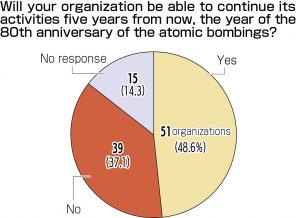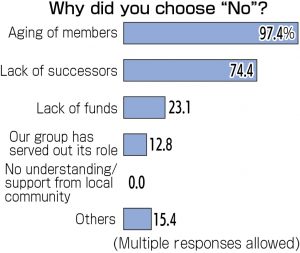Chugoku Shimbun survey: 37% of A-bomb survivors’ organizations to have difficulty continuing activities by 2025
Jul. 20, 2020
by Tsuyoshi Kubota, Staff Writer
Poor outlook due to aging membership, lack of successors On July 19, a nationwide survey’s results showed that nearly 40 percent (37.1 percent) of A-bomb survivors’ organizations queried believe that continued activities will be difficult by 2025, the 80th year after the atomic bombings. The survey was conducted by the Chugoku Shimbun in accordance with the 75th anniversary of the atomic bombings this year. As for why the organizations might not be able to remain active, 97.4 percent of respondents cited the aging of members, and 74.4 percent a lack of successors. Respondents were allowed to give multiple answers. A-bomb survivors’ groups have been making assiduous efforts to pass on memories of the atomic bombings and to call for elimination of nuclear weapons, but a considerable number have not been able to lay out a clear vision for the future.
The annual survey has been conducted in accordance with the anniversary dates of the atomic bombings since 2015, the 70th anniversary of the bombings, except for 2018, when western Japan suffered widespread damage from torrential rains. The organizations covered by this survey include nationwide prefectural-level survivors’ groups and regional groups in the Chugoku region, comprised of Hiroshima and the four surrounding prefectures. In this year’s survey, 107 organizations across the nation were asked to participate, and 105 groups, or 98.1 percent, responded.
To a question regarding whether they think their organization will be able to continue its activities five years from now, the year of the 80th anniversary of the atomic bombings, 39 groups, or 37.1 percent of the total, responded “No.” Among the nationwide prefectural organizations, 29.3 percent responded “No,” with 42.2 percent of the regional groups in the five Chugoku-region prefectures also replying “No.” With this, the comparatively smaller regional groups appear to be facing harsher conditions.
As for the reasons the respondents answered “No,” the largest group, at 97.4 percent of the total, cited “Aging of members” (multiple answers were allowed). Aging of the survivors who lead the groups’ activities portends difficulties regarding their continued existence. Other responses were “Lack of successors,” selected by 74.4 percent, “Lack of funds” at 23.1 percent, and “Our group has served out its role,” comprising 12.8 percent.
Fifty-one groups, or 48.6 percent of the total, responded “Yes” to the question. The remaining 15 groups, or 14.3 percent, offered no response. Many respondents added notes in the survey’s margins, such as “We do not know” or “It’s difficult to respond either yes or no.”
According to Japan’s Ministry of Health, Labour and Welfare, the number of Atomic Bomb Survivor’s Certificate holders was 136,682, as of the end of March 2020, falling under 140,000 for the first time. The number is less than 40 percent of the peak of 372,264 recorded at the end of March 1981. The average age of the certificate holders was 83.31 years, a record high.
The questionnaire also included questions on current activities. Eight organizations, or 7.6 percent of the total, responded they have events or activities that would not be continued after the 75th anniversary of the atomic bombings. Fifteen groups, or 14.3 percent, said they plan to disband or to merge with other groups. Twenty-five groups, or 23.8 percent, said they have not been able to perform regular group activities. Forty-seven groups, or 44.8 percent, said there were second-generation survivors’ organizations either inside or outside their groups.
How survey was conducted
Questionnaires were sent by mail in mid-June to survivors’ organizations, and some of the groups also participated in face-to-face or telephone interviews. The 107 organizations surveyed included prefectural chapters of the Japan Confederation of A-bomb Sufferers Organizations (Nihon Hidankyo); the Hiroshima Hidankyo, chaired by Kunihiko Sakuma, which serves as an observer; the Tsuruoka Survivors Association in the city of Tsuruoka, Yamagata Prefecture, which has no prefectural Hidankyo organization but does maintain ties with Nihon Hidankyo; and branches of the nationwide prefectural bodies and regional groups in the five prefectures of the Chugoku region. The 2015 questionnaire, the first such survey, was conducted in accordance with the 70th anniversary of the atomic bombings and covered 125 organizations, but because many groups have disbanded, that number has declined over time.
(Originally published on July 20, 2020)
Poor outlook due to aging membership, lack of successors On July 19, a nationwide survey’s results showed that nearly 40 percent (37.1 percent) of A-bomb survivors’ organizations queried believe that continued activities will be difficult by 2025, the 80th year after the atomic bombings. The survey was conducted by the Chugoku Shimbun in accordance with the 75th anniversary of the atomic bombings this year. As for why the organizations might not be able to remain active, 97.4 percent of respondents cited the aging of members, and 74.4 percent a lack of successors. Respondents were allowed to give multiple answers. A-bomb survivors’ groups have been making assiduous efforts to pass on memories of the atomic bombings and to call for elimination of nuclear weapons, but a considerable number have not been able to lay out a clear vision for the future.
The annual survey has been conducted in accordance with the anniversary dates of the atomic bombings since 2015, the 70th anniversary of the bombings, except for 2018, when western Japan suffered widespread damage from torrential rains. The organizations covered by this survey include nationwide prefectural-level survivors’ groups and regional groups in the Chugoku region, comprised of Hiroshima and the four surrounding prefectures. In this year’s survey, 107 organizations across the nation were asked to participate, and 105 groups, or 98.1 percent, responded.
To a question regarding whether they think their organization will be able to continue its activities five years from now, the year of the 80th anniversary of the atomic bombings, 39 groups, or 37.1 percent of the total, responded “No.” Among the nationwide prefectural organizations, 29.3 percent responded “No,” with 42.2 percent of the regional groups in the five Chugoku-region prefectures also replying “No.” With this, the comparatively smaller regional groups appear to be facing harsher conditions.
As for the reasons the respondents answered “No,” the largest group, at 97.4 percent of the total, cited “Aging of members” (multiple answers were allowed). Aging of the survivors who lead the groups’ activities portends difficulties regarding their continued existence. Other responses were “Lack of successors,” selected by 74.4 percent, “Lack of funds” at 23.1 percent, and “Our group has served out its role,” comprising 12.8 percent.
Fifty-one groups, or 48.6 percent of the total, responded “Yes” to the question. The remaining 15 groups, or 14.3 percent, offered no response. Many respondents added notes in the survey’s margins, such as “We do not know” or “It’s difficult to respond either yes or no.”
According to Japan’s Ministry of Health, Labour and Welfare, the number of Atomic Bomb Survivor’s Certificate holders was 136,682, as of the end of March 2020, falling under 140,000 for the first time. The number is less than 40 percent of the peak of 372,264 recorded at the end of March 1981. The average age of the certificate holders was 83.31 years, a record high.
The questionnaire also included questions on current activities. Eight organizations, or 7.6 percent of the total, responded they have events or activities that would not be continued after the 75th anniversary of the atomic bombings. Fifteen groups, or 14.3 percent, said they plan to disband or to merge with other groups. Twenty-five groups, or 23.8 percent, said they have not been able to perform regular group activities. Forty-seven groups, or 44.8 percent, said there were second-generation survivors’ organizations either inside or outside their groups.
How survey was conducted
Questionnaires were sent by mail in mid-June to survivors’ organizations, and some of the groups also participated in face-to-face or telephone interviews. The 107 organizations surveyed included prefectural chapters of the Japan Confederation of A-bomb Sufferers Organizations (Nihon Hidankyo); the Hiroshima Hidankyo, chaired by Kunihiko Sakuma, which serves as an observer; the Tsuruoka Survivors Association in the city of Tsuruoka, Yamagata Prefecture, which has no prefectural Hidankyo organization but does maintain ties with Nihon Hidankyo; and branches of the nationwide prefectural bodies and regional groups in the five prefectures of the Chugoku region. The 2015 questionnaire, the first such survey, was conducted in accordance with the 70th anniversary of the atomic bombings and covered 125 organizations, but because many groups have disbanded, that number has declined over time.
(Originally published on July 20, 2020)









